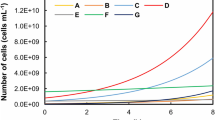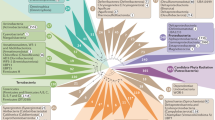Abstract
The growth of twelve methanotrophic strains within the genus Methylomonas, including the type strains of Methylomonas methanica and Methylomonas koyamae, was evaluated with 40 different variations of standard diluted nitrate mineral salts medium in 96-well microtiter plates. Unique profiles of growth preference were observed for each strain, showing a strong strain dependency for optimal growth conditions, especially with regards to the preferred concentration and nature of the nitrogen source. Based on the miniaturized screening results, a customized medium was designed for each strain, allowing the improvement of the growth of several strains in a batch setup, either by a reduction of the lag phase or by faster biomass accumulation. As such, the maintenance of fastidious strains could be facilitated while the growth of fast-growing Methylomonas strains could be further improved. Methylomonas sp. R-45378 displayed a 50 % increase in cell dry weight when grown in its customized medium and showed the lowest observed nitrogen and oxygen requirement of all tested strains. We demonstrate that the presented miniaturized approach for medium optimization is a simple tool allowing the quick generation of strain-specific growth preference data that can be applied downstream of an isolation campaign. This approach can also be applied as a first step in the search for strains with biotechnological potential, to facilitate cultivation of fastidious strains or to steer future isolation campaigns.


Similar content being viewed by others
References
Anthony C (1982) Biochemistry of methylotrophs. The Academic Press, London
Bodelier PLE, Laanbroek HJ (2004) Nitrogen as a regulatory factor of methane oxidation in soils and sediments. FEMS Microbiol Ecol 47(3):265–277. doi:10.1016/s0168-6496(03)00304-0
Bodrossy L, Holmes EM, Holmes AJ, Kovacs KL, Murrell JC (1997) Analysis of 16S rRNA and methane monooxygenase gene sequences reveals a novel group of thermotolerant and thermophilic methanotrophs, Methylocaldum gen. nov. Arch Microbiol 168(6):493–503. doi:10.1007/s002030050527
Bowman J (2006) The methanotrophs—the families Methylococcaceae and Methylocystaceae. Chapter 3.1.14. In: Dworkin M, Falkow S, Rosenberg E, Schleifer K-H, Stackebrandt E (eds) The prokaryotes, vol 5, 3rd edn., pp 266–289. doi:10.1007/0-387-30745-1_15
Bowman JP, Sly LI, Nichols PD, Hayward AC (1993) Revised taxonomy of the methanotrophs—description of Methylobacter Gen-Nov., emendation of Methylococcus, validation of Methylosinus and Methylocystis species, and a proposal that the family Methylococcaceae includes only the group-I methanotrophs. Int J Syst Bacteriol 43(4):735–753. doi:10.1099/00207713-43-4-735
Cataldo DA, Maroon M, Schrader LE, Youngs VL (1975) Rapid colorimetric determination of nitrate in plant tissue by nitration of salicylic acid. Commun Soil Sci Plant Anal 6(1):71–80. doi:10.1080/00103627509366547
Dalton H (2005) The Leeuwenhoek lecture 2000—the natural and unnatural history of methane-oxidizing bacteria. Philos T R Soc B 360(1458):1207–1222. doi:10.1098/rstb.2005.1657
Danilova OV, Kulichevskaya IS, Rozova ON, Detkova EN, Bodelier PL, Trotsenko YA, Dedysh SN (2012) Methylomonas paludis sp. nov., the first acid-tolerant member of the genus Methylomonas, from an acidic wetland. Int J Syst Evol Microbiol 63:2282–2289. doi:10.1099/ijs.0.045658-0
Dedysh SN, Panikov NS, Tiedje JM (1998) Acidophilic methanotrophic communities from Sphagnum peat bogs. Appl Environ Microbiol 64(3):922–929
Doronina NV, Ezhov VA, Trotsenko YA (2008) Growth of Methylosinus trichosporium OB3b on methane and poly-beta-hydroxybutyrate biosynthesis. Appl Biochem Microbiol 44(2):182–185. doi:10.1134/s0003683808020099
Dunfield PF, Khmelenina VN, Suzina NE, Trotsenko YA, Dedysh SN (2003) Methylocella silvestris sp. nov., a novel methanotroph isolated from an acidic forest cambisol. Int J Syst Evol Microbiol 53:1231–1239. doi:10.1099/ijs.0.02481-0
Hanson RS, Hanson TE (1996) Methanotrophic bacteria. Microbiol Rev 60(2):439–471
Hoefman S, van der Ha D, De Vos P, Boon N, Heylen K (2012) Miniaturized extinction culturing is the preferred strategy for rapid isolation of fast-growing methane-oxidizing bacteria. Microb Biotechnol 5(3):368–378. doi:10.1111/j.1751-7915.2011.00314.x
Jiang H, Chen Y, Jiang P, Zhang C, Smith TJ, Murrell JC, Xing X-H (2010) Methanotrophs: multifunctional bacteria with promising applications in environmental bioengineering. Biochem Eng J 49(3):277–288. doi:10.1016/j.bej.2010.01.003
Kalyuzhnaya MG, Khmelenina VN, Kotelnikova S, Holmquist L, Pedersen K, Trotsenko YA (1999) Methylomonas scandinavica sp. nov., a new methanotrophic psychrotrophic bacterium isolated from deep igneous rock ground water of Sweden. Syst Appl Microbiol 22(4):565–572. doi:10.1016/S0723-2020(99)80010-1
Kip N, Ouyang W, van Winden J, Raghoebarsing A, van Niftrik L, Pol A, Pan Y, Bodrossy L, van Donselaar EG, Reichart GJ, Jetten MS, Damste JS, Op den Camp HJ (2012) Detection, isolation, and characterization of acidophilic methanotrophs from Sphagnum mosses. Appl Environ Microbiol 77(16):5643–5654. doi:10.1128/AEM.05017-11
Koh SC, Bowman JP, Sayler GS (1993) Soluble methane monooxygenase production and trichloroethylene degradation by a Type-I methanotroph, Methylomonas methanica-68-1. Appl Environ Microbiol 59(4):960–967
Kolesnikov OM, Dedysh SN, Panikov NS (2004) Inhibition of growth and methane consumption in Methylocapsa acidiphila by mineral salts. Microbiology 73(4):488–490. doi:10.1023/B:MICI.0000036997.13271.f9
Lee SW, Im J, DiSpirito AA, Bodrossy L, Barcelona MJ, Semrau JD (2009) Effect of nutrient and selective inhibitor amendments on methane oxidation, nitrous oxide production, and key gene presence and expression in landfill cover soils: characterization of the role of methanotrophs, nitrifiers, and denitrifiers. Appl Microbiol Biotechnol 85(2):389–403. doi:10.1007/s00253-009-2238-7
Molinuevo-Salces B, Garcia-Gonzalez MC, Gonzalez-Fernandez C (2010) Performance comparison of two photobioreactors configurations (open and closed to the atmosphere) treating anaerobically degraded swine slurry. Bioresour Technol 101(14):5144–5149. doi:10.1016/j.biortech.2010.02.006
Park S, Hanna ML, Taylor RT, Droege MW (1991) Batch cultivation of Methylosinus trichosporium OB3b. 1. Production of soluble methane monooxygenase. Biotechnol Bioeng 38(4):423–433. doi:10.1002/bit.260380412
Park SH, Shah NN, Taylor RT, Droege MW (1992) Batch cultivation of Methylosinus trichosporium OB3b. 2. Production of particulate methane monooxygenase. Biotechnol Bioeng 40(1):151–157. doi:10.1002/bit.260400121
Reay DS, Nedwell DB (2004) Methane oxidation in temperate soils: effects of inorganic N. Soil Biol Biochem 36(12):2059–2065. doi:10.1016/j.soilbio.2004.06.002
Scheutz C, Kjeldsen P, Bogner JE, De Visscher A, Gebert J, Hilger HA, Huber-Humer M, Spokas K (2009) Microbial methane oxidation processes and technologies for mitigation of landfill gas emissions. Waste Manag Res 27(5):409–455. doi:10.1177/0734242x09339325
Semrau JD (2011) Bioremediation via methanotrophy: overview of recent findings and suggestions for future research. Front Microbiol 2:209. doi:10.3389/fmicb.2011.00209
Semrau JD, DiSpirito AA, Yoon S (2010) Methanotrophs and copper. FEMS Microbiol Rev 34(4):496–531. doi:10.1111/j.1574-6976.2010.00212.x
Shah NN, Park S, Taylor RT, Droege MW (1992) Cultivation of Methylosinus trichosporium OB3b. 3. Production of particulate methane monooxygenase in continuous culture. Biotechnol Bioeng 40(6):705–712. doi:10.1002/bit.260400609
Taylor S, Ninjoor V, Dowd DM, Tappel AL (1974) Cathepsin B2 measurement by sensitive fluorometric ammonia analysis. Anal Biochem 60(1):153–162. doi:10.1016/0003-2697(74)90140-7
Tsubota J, Eshinimaev BT, Khmelenina VN, Trotsenko YA (2005) Methylothermus thermalis gen. nov., sp. nov., a novel moderately thermophilic obligate methanotroph from a hot spring in Japan. Int J Syst Evol Microbiol 55:1877–1884. doi:10.1099/ijs.0.63691-0
Wendlandt KD, Stottmeister U, Helm J, Soltmann B, Jechorek M, Beck M (2010) The potential of methane-oxidizing bacteria for applications in environmental biotechnology. Eng Life Sci 10(2):87–102. doi:10.1002/elsc.200900093
Whittenbury R, Phillips KC, Wilkinson JF (1970) Enrichment, isolation and some properties of methane-utilizing bacteria. J Gen Microbiol 61:205–217. doi:10.1099/00221287-61-2-205
Wilshusen JH, Hettiaratchi JP, De Visscher A, Saint-Fort R (2004) Methane oxidation and formation of EPS in compost: effect of oxygen concentration. Environ Pollut 129(2):305–314. doi:10.1016/j.envpol.2003.10.015
Wise MG, McArthur JV, Shimkets LJ (1999) Methanotroph diversity in landfill soil: isolation of novel type I and type II methanotrophs whose presence was suggested by culture-independent 16S ribosomal DNA analysis. Appl Environ Microbiol 65(11):4887–4897
Zhang YX, Xin JY, Chen LL, Song H, Xia CU (2008) Biosynthesis of poly-3-hydroxybutyrate with a high molecular weight by methanotroph from methane and methanol. J Nat Gas Chem 17(1):103–109. doi:10.1016/s1003-9953(08)60034-1
Acknowledgments
This work was funded by the Geconcerteerde Onderzoeksactie (GOA) of Ghent University (BOF09/GOA/005). Kim Heylen is supported by the Flemish Fund for Scientific Research (FWO11/PDO/084). David van der Ha was supported by funds from the Institute for the Promotion of Innovation through Science and Technology in Flanders (IWT-Vlaanderen, SB-83259).
Author information
Authors and Affiliations
Corresponding author
Rights and permissions
About this article
Cite this article
Hoefman, S., van der Ha, D., Boon, N. et al. Customized media based on miniaturized screening improve growth rate and cell yield of methane-oxidizing bacteria of the genus Methylomonas . Antonie van Leeuwenhoek 105, 353–366 (2014). https://doi.org/10.1007/s10482-013-0083-2
Received:
Accepted:
Published:
Issue Date:
DOI: https://doi.org/10.1007/s10482-013-0083-2




